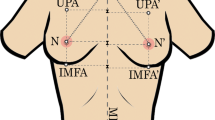Abstract
Background
Accurate assessment of breast volume is helpful in preoperative planning and intraoperative judgment in both cosmetic and reconstructive breast surgery. In this prospective study, a formula was derived using machine learning algorithm (Gradient Boosted Model).
Method
A prospective study was performed on 39 female-to-male transgender patients. Bilateral mastectomy was done for all patients. Preoperative anthropometric measurements were performed on 78 breasts of these patients. Weight of breasts was calculated postoperatively with digital scale (weight), and then volume of breasts was calculated with the calibrated container (water displacement technique). Authors built a model based on Python CatBoostClassifier. Finally, an android application was built for ease of real-time utilization.
Results
Eight anthropometric measurements were collected preoperatively as independent variables. Breast vertical perimeter at lower half, upper pole, sternal notch to nipple and nipple to IMF had most correlation with volume and weight. Based on machine learning model, the following formula established: Breast volume = (breast width) × 24.69 + (nipple to IMF) × 49.03 − (sternal notch to nipple) × 1.34 + (anterior axillary line to medial border) × 6.57 − (upper pole) × 1.27 − (chest perimeter IMF) × 5.63 + (chest perimeter nipple) × 10.40 + (breast vertical perimeter at lower half) × 9.20 − 1133.74. The R2 of the model is 0.93, and RMSE is 62.4.
Conclusion
Our formula is an accurate method for preoperative breast volume assessment. We built an android App (Breast Volume Predictor) for the real-time utilization of resulting formula. It is available at Google Play Store for free download.
Level of Evidence IV
This journal requires that authors assign a level of evidence to each article. For a full description of these Evidence-Based Medicine ratings, please refer to the Table of Contents or the online Instructions to Authors www.springer.com/00266.



Similar content being viewed by others
References
Herold C, Ueberreiter K, Busche MN et al (2013) Autologous fat transplantation: volumetric tools for estimation of volume survival. A systematic review. Aesthetic Plast Surg 37:380–387
Choppin SB, Wheat JS, Gee M et al (2016) The accuracy of breast volume measurement methods: a systematic review. Breast 28:121–129
Killaars RC, Preuβ MLG, de Vos Camille NJP, van Berlo CJLY, Lobbes MBI, van der Hulst RRWJ, Piatkowski AA (2020) Clinical assessment of breast volume: can 3D imaging be the gold standard? Plast Reconstr Surg Golb Open 8(11):1158
Grossman AJ, Roudner LA (1980) A simple means for accurate breast volume determination. Plast Reconstr Surg 66(6):851–852
Edsander-Nord Å, Wickman M, Jurell G (1996) Measurement of breast volume with thermoplastic casts. Scand J Plast Reconstr Hand Surg 30:129–132
Bulstrode N, Bellamy E, Shrotria S (2001) Breast volume assessment: comparing five different techniques. Breast 10:50–62
Kayar R, Civelek S, Cobanoglu M, O gungor, H Catal, M emiroglu, (2011) Five methods of breast volume measurement: a comparative study of measurements of specimen volume in 30 mastectomy cases. Breast Cancer: Basic Clin Res 5:BCBCR-S6128
Dorogush AV, Ershov V, Gulin A (2018) CatBoost: gradient boosting with categorical features support. arXiv:1810.11363
Karwasra I, Beniwal A (2018) Breast volume estimation by anthropometry. J Med Sci Clin Res 6(1):32622–32628
Henseler H, Hille-Betz U, Vogt PM (2015) Validation of subjective estimates of female breast volume and comparison with objective methods. Handchir Mikrochir Plast Chir 47(6):371–377
Bauman FG (1970) Volumetric measurement of the human breast and breast tissue before and during mammaplasty. Br J Plast Surg 23:263–264
Eric M, Anderla A, Stefanovic D, Drapsin M (2014) Breast volume estimation from systemic series of CT scans using the Cavalieri principle and 3D reconstruction. Int J Surg 12(9):912–917
Palin WE Jr, von Fraunhofer JA, Smith DJ Jr (1986) Measurement of breast volume: comparison of techniques. Plast Reconstr Surg 77(2):253–255
Caruso MK, Guillot TS, Nguyen T, Frank L (2006) Greenway the cost effectiveness of three different measures of breast volume. Aesth Plast Surg 30:16–20
Kalbhen CL, McGill JJ, Fendley PM, Corrigan KW, Angelats J (1999) Mammographic determination of breast volume: comparing different methods. AJR 173(6):1643–1649
Chae MP, Rozen WM, Spychal RT, Hunter-Smith DJ (2016) Breast volumetric analysis for aesthetic planning in breast reconstruction: a literature review of techniques. Glan Surg 5(2):212–226
Mahmoud EO, Hosna AM, Bothaina A, Mohamed ES (2006) Assessment of the breast volume by a new simple formula. Indian J Plast Surg 39(1):13–16
Qiao Q, Zhou G, Ling YC (1997) Breast volume measurement in young Chinese women and clinical applications. Aesth Plast Surg 21:362–368
Sigurdson LJ, Kirkland SA (2006) Breast volume determination in breast hypertrophy: an accurate method using two anthropometric measurement. Plast Reconstr Surg 118(2):313–320
Ghojogh B, Crowley M (2019) The theory behind overfitting, cross validation, regularization, bagging and boosting: tutorial. arXiv:1905.12787
Longo B, Farcomeni A, Ferri G, Campanale A, Sorotos M, Santanelli F (2013) The BREAST-V: a unifying predictive formula for volume assessment in small, medium, and large breasts. Plast Reconstr Surg 132(1):1e–7e
Chai T, Draxler RR (2014) Root mean square error (RMSE) or mean absolute error (MAE)? Arguments against avoiding RMSE in literature. Geosci Model Dev 7:1247–1250
Author information
Authors and Affiliations
Corresponding author
Ethics declarations
Conflict of interest
The authors declare that they have no conflicts of interest to disclose.
Informed Consent
Informed consent was obtained from all participants.
Ethical Approval
The study was approved by the ethics committee of the IR.IUMS.REC under the approval number: IR.IUMS.FMD.REC.1399.343
Additional information
Publisher's Note
Springer Nature remains neutral with regard to jurisdictional claims in published maps and institutional affiliations.
Rights and permissions
About this article
Cite this article
Akhoondinasab, M., shafaei, Y., Rahmani, A. et al. A Machine Learning-Based Model for Breast Volume Prediction Using Preoperative Anthropometric Measurements. Aesth Plast Surg 48, 243–249 (2024). https://doi.org/10.1007/s00266-022-02937-0
Received:
Accepted:
Published:
Issue Date:
DOI: https://doi.org/10.1007/s00266-022-02937-0




